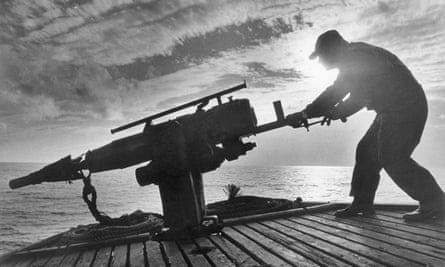A cycling holiday on the Jutland peninsula’s ‘Fjordmino’ is a gentle procession of quiet roads, ferry rides, cute B&Bs and islands
When I heard about Denmark’s “island of wild rabbits”, I knew I had to check it out. And the isle of Endelave did not disappoint. Rabbits in fields, rabbits in gardens, rabbits on the road, rabbits emerging from wild rose bushes – everywhere my companion and I looked played out like one of the happier scenes from Watership Down, before all the trouble starts.
“So there are thousands of them here?” I asked Birgit, our guide to Endelave’s Kanino, the island’s new 13-mile coast walk (kanin being Danish for rabbit).
“There are tens of thousands,” she said. Did we detect a slight sigh in her voice? I think we did.

Our visit to Endelave, on the Kattegat Sea between Denmark and Sweden, was a detour off the country’s other riff on “camino”, the Fjordmino. Opened last year, the 35-mile circular cycle trail and (partially overlapping) 38-mile walking route make a circuit of Horsens fjord in East Jutland.
We began in the small city of Horsens. With an early start it’s possible to get there by train from London in a day. We took the 7am Eurostar to Brussels, then trundled through Germany and across the border, arriving late at night for the short walk through Horsens’ quiet streets to Jørgensen’s hotel, an 18th-century baroque mansion built by a wealthy merchant.

We rather fell for the immense old city maps on the walls of our huge room and the elaborate cornicing, featuring an orchestra’s worth of golden musical instruments.
In the morning, our hire bikes were delivered by Dennis from Cykelsmeden Odder and, after a lunch of a delicious melange of asparagus and other locally grown vegetables at harbourside bistro Nior, we headed out of town on a roadside cycle path, looking out for the Fjordmino’s frequent “route 87” waymarkers. There are a few sections of gentle off-roading along the mostly flat route, but it generally follows metalled cycle paths and very quiet roads.
Travelling clockwise (you can go either way), we soon found ourselves passing peacefully through a tunnel of trees on a disused railway line strewn with purple alliums and yellow loosestrife. We were on Jutland’s east coast, not quite halfway up the peninsula, and the landscape around Horsens was all arable fields, small well-groomed villages and wooden church spires. Red kites and buzzards patrolled the skies, leaving the water below to avocets, geese, cormorants, oystercatchers and rafts of eiders. Our only disappointment was not spotting the fjord’s white-tailed eagles.

Our first port of call, about 10 miles in, was a B&B called Reballegård near Søvind owned by a couple called Tine and Magnus. Tine said their mansion-like 150-year-old home had belonged to her grandparents. It had also been a retirement home (“As a child,” she said, “I used to roll cigarettes for the old people”), a boys’ home, a rehab centre, a psychiatric clinic and a commune. It was a wreck by the time the pair bought it in 2022. Their work in restoring the house is “a lifelong project” but the parts they have finished are immaculate. And they are clearly pleased to be welcoming guests, of whom we were among the first. We passed a convivial evening together, sitting in a shed making pizzas from scratch, adding toppings from the couple’s kitchen garden.
We sampled delicious sparkling wine and some very moreish apple gin made from their own cider and botanicals,
The next day, another eight miles on, we dropped in on Lone and Søren at their Brandbygegaard vineyard and orchard, which is right on the route. For 30 years they have gone to extraordinary lengths to make their organic enterprise as eco-friendly as possible, rewilding 90% of it.
“It took Søren seven years to dig the lake,” Lone said with a chuckle. But global warming has hit them badly. They have 1,000 vines, but two years ago they had to give away all the plants of one variety that could no longer cope with Denmark’s warmer autumns. “We can only remain optimistic about the climate,” Søren said, “by making this place better.”
We sampled one of their delicious sparkling wines and some very moreish apple gin made from their own cider and botanicals, the latter changing with each vintage depending on what has harvested well. “It’s the taste of the year in a bottle,” said Søren. Unsurprisingly, their annual summer three-week pop-up restaurant, specialising in homegrown ingredients, had sold out.
Of course, if you’re going to cycle around a fjord, the time will come when you have to cross its mouth. Our free tourist office map of the Fjordmino route took us over a bridge on to the large island of Alrø, from where we caught the dinky “cycle ferry” (March-October) to a much smaller island, Hjarnø.
As the author of books on tiny islands and tiny churches, I was thrilled to have a poke around Hjarnø’s bijou place of worship (the second-smallest in Denmark) with its intricate model Viking ship hanging from the ceiling.





